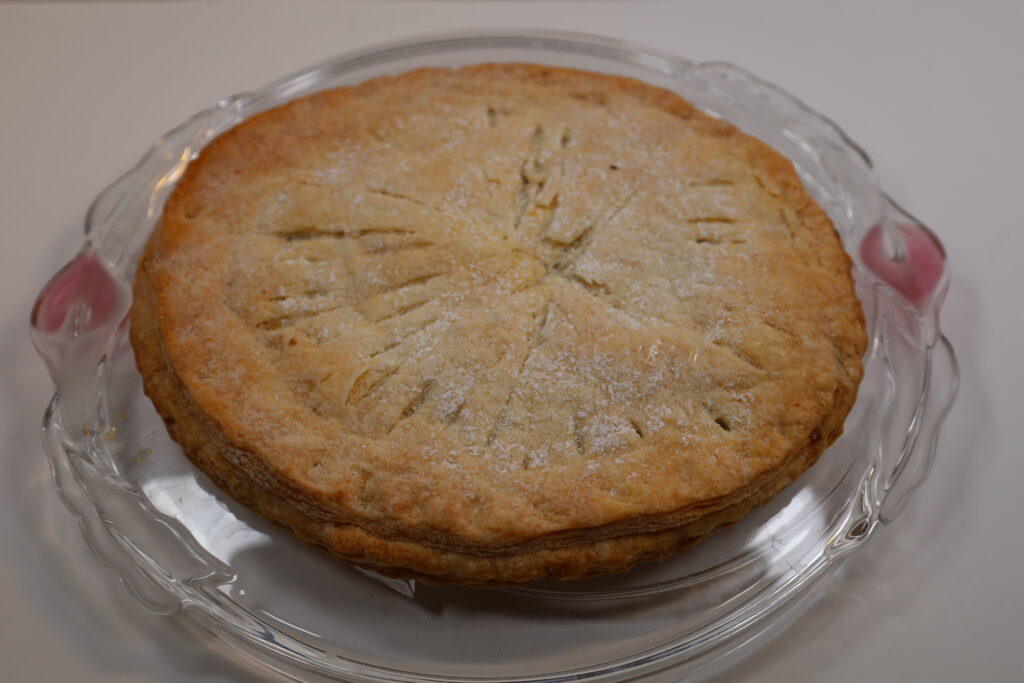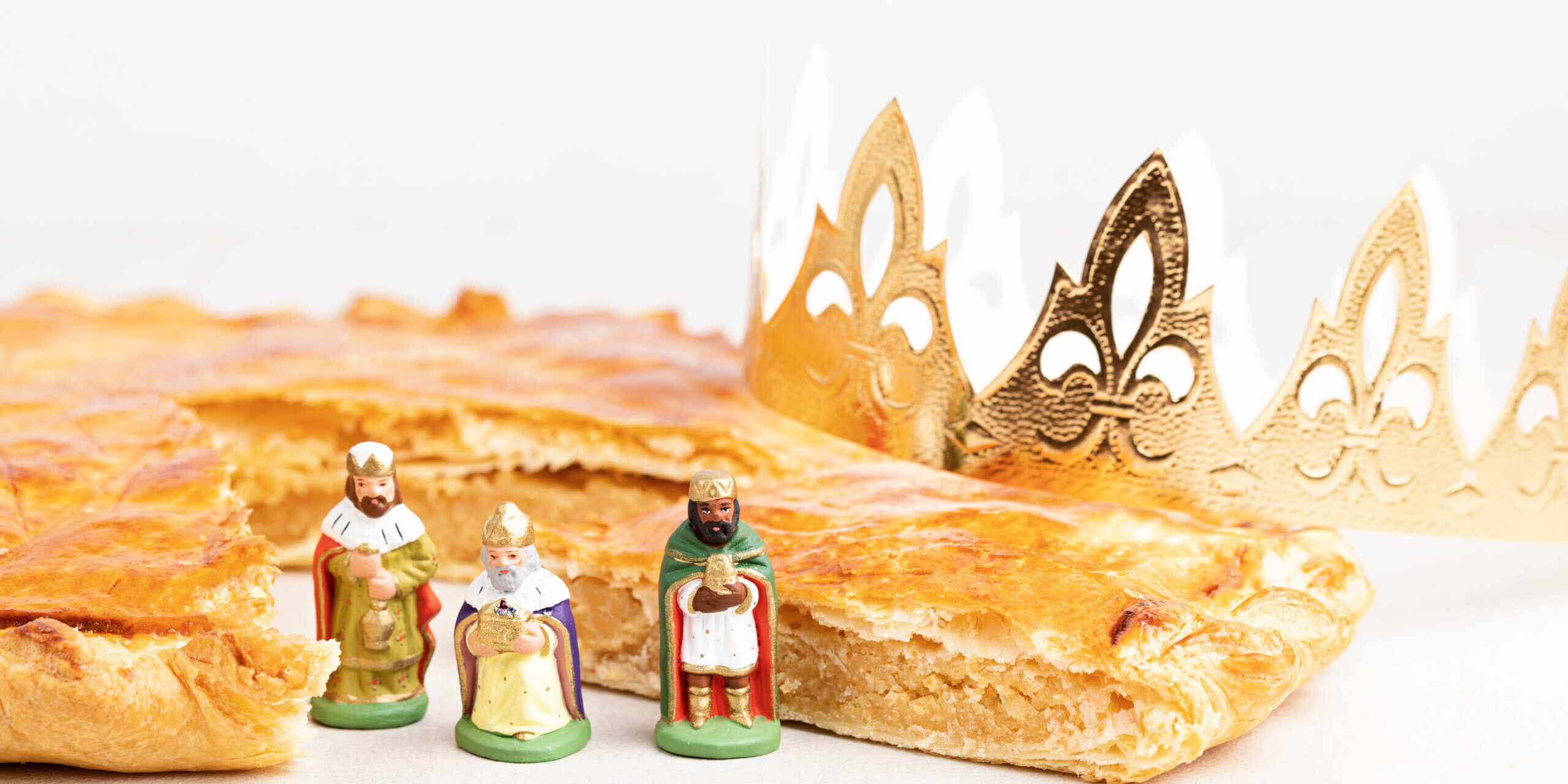Puff pastry with an almond filling, what is not to like? The galette des rois is such a desert. The history of this dish is a bit convoluted but fascinating, and I hope I am stating it accurately. Its roots take place in western Gaul with the Carnut peoples. Once occupied by the Roman’s, they introduced the almond. The Carnutes, it is said, developed the first recipe for an almond cake, the first pithiviers, called the fondant. At the time the cake was a celebration of Saturnalia, the festival of the winter solstice. Both masters and slaves sat at table and ate together. A bean, either white or black, was placed into one of the dishes of that feast and whoever ended up with the bean was called the king of the feast.
In the 13th century the galette des rois became a Christian religious custom, however without the puff pastry. The cake was a celebration of the Epiphany, the arrival of the three wise men, Melchior, Caspar and Balthazar, from three continents, Asia, Africa and Europe, to honor the baby Jesus. Whoever received the bean was still called the “King”. Although, originally, the galette des rois was filled with an almond filling, it was apparently not frangipani. The term derives from the Italian, frangere il pane or “breaking the bread”. Although the name is from the 11th century, actual frangipani developed during the 16th century. Marquis Muzio Frangipani, developed an almond cream used in the cake. A Pithivier cake filled with this almond cream originated in the 17th century in the town of Pithivier in Loire Valley but did not include puff pastry. Puff pastry was not developed until the 18th century and immortalized by the Prince de Condé’s cook, Feuillet. The pastry spread very quickly throughout France and was used for the Pithivier cakes. A Pithivier cake is one that can be savory or sweet and uses puff pastry. Recipes can be found for potato, onions, chicken, vegetables, apricots, cherries and a multitude of other fillings both sweet and savory.
The galette des rois is a type of Pithivier cake, made with puff pastry and filled with frangipani and served at or during Epiphany. Although location in France determined many of the recipes and names of dishes, the classic galette des rois is now enjoyed throughout France as are pithivier cakes generally.
As mentioned above the original roots of the cake had a bean or “feve” inserted somewhere in the cake. The bean has been replaced by a small plastic or china “feve”. The celebration is still very present and active in France. In many families the “king” leads a traditional dance after finding the “feve”. Note the picture for this post above, there is the cake, the crown and the “feve“.
As an interesting note, during the French Revolution the name was changed to gâteau de l’egalité, since both royalty and religion were eschewed at the time. Fortunately, the French have come to their senses and the name galette des rois returned.
Of further interest, a similar multicolored cake “Kings Cake” is made in New Orleans, undoubtedly originating from French roots. This is served at or around Epiphany and through carnivale, i.e., mardi gras. Although it seems to have unfortunately lost it’s religious heritage.

My cake didn’t come out anywhere near as good looking as a professional galette des rois. The technique of inscribing the surface of the cake top with a decorative pattern is a skill for which I need lots of work. But the taste was tremendous. I used a home made puff pastry, which probably did not puff up as large, but the taste was well worth the effort. I have included the recipe for both the puff pastry and frangipani below. A little creme Crème fraîche or whipped cream would have gone great, but by itself, along with a digestif, the desert is just wonderful.
Galette des rois
Ingredients
- 500 grams (1 ⅛ pounds) puff pastry*, recipe follows
- 3 ½ ounces Frangipane, recipe follows
- 1 large egg
- 2 tsp whole milk
- pinch sea salt
- Powdered sugar
Instructions
- Split the pastry into two pieces enough for the top and bottom rounds. Keep one in the refrigerator while you roll out the scond.
- On a flat, clean floured surface, roll out the puff pastry dough. If you have a circular indicator on your floured board, as I do, this is fairly easy. Just roll out the dough until you have the appropriate circle covered.
- Roll our the dough to about 1/16 inch thick. The top roll should be about 9 ½ inches in diameter. The second piece about 10 inches, about ½ inch larger than the first.
- Place the first dough circle on a parchment covered cookie sheet.
- With a brush wet the edge of the first sheet well, about ½ inch in from the edge, all the way around the sheet.
- Place the Frangipane on the first circle (easier if brought to room temperature first). Since I love this I used up all of the recipe below for one cake. Spread it out evenly using an offset spatula. Keep it about ½ inch free from the edge.
- Cover with the second sheet and seal the edges well.
- Press the edges and try to end up with a scalloped shape.
- Place in the refrigerator for at least 30 minutes.
- Preheat the over to 400 degrees F.
- Remove from the refrigerator, place a 9 inch tart ring over the dough and cut off the edges.
- Now using a very sharp knife make a design on the top of the pastry. You can score lines, make wavy lines … all without cutting through the top sheet of dough.
- Bake for 30 minutes. REmove from the oven, increase the temperature to 425 degrees F.
- Dust the top of the cake with powdered sugar. Place in the oven when it reaches the 425 degrees and let the powered sugar glaze. Just a few minutes. Focus and watch this carefully as you don't want to burn the cake!
- Remove from the oven, cool on a wire rack.
- Serve and enjoy. You can add whipped cream or crème fraîche.
Notes
Frangipane (Almond Cream)
Ingredients
- ½ cup Powdered sugar
- 3 ounces finely ground almonds
- 4½ tbps unsalted butter (at room temperature)
- 1¼ tbsp All purpose flour
- 1 large egg
- 1 tbsp good quality rum
- ¼ tsp orange zest (or pure orange extract)
- ¼ tsp pure vanilla
Instructions
- Shift the powered sugar and ground almonds through a fine strainer. Whisk well.
- In a bowl place the butter and whip it using a whisk or hand help mixer. Whisk until creamy.
- Add the powdered sugar and almonds. Whisk and mix well.
- Add the egg and mix well.
- Add the orange extract, vanilla and mix well. When done you should have a very smooth light "cream".
- This can be done a day before you make the galette. Place in the refrigerator until ready to use, or use as needed.
Puff Pastry
Ingredients
- 1¼ cups cold unsalted butter
- ½ cup very cold water
- ¾ tsp sea salt
- 2 cups King Arthur All-Purpose Flour
Instructions
- Use your food processor, this makes things so much easier.
- In a bowl mix the flour and salt, whisk well.
- Cube the butter but keep it in the refrigerator until ready to add to the dough.
- Add the flour mixture to the food processor bowl. Add ¾ cup of the butter and the pulse. Pulse about 12-14 times until you had a sandy grainy appearance of the dough.
- Add the other ¾ cup of butter and pulse about 3 times.
- Add the cold water and pulse about 5 times.
- Empty the dough onto a flat clean floured surface and knead. Do not overknead or you will ruin the dough. Knead about 20-30 seconds until you have a dough ball. You will see pieces of butter in the dough, this is fine, don't worry.
- Roll out the dough using a rolling pin to about 12 x 18 inches. Fold it over twice, cover with plastic and place in the refrigerator. Leave this for at least 2 hours. You can vacume pack and freeze the dough. It will keep for months this way. Just freezing it will keep for about a month.
- Your dough is finished once it has set in the refrigerator. Roll out as indicated above in the galette recipe.








